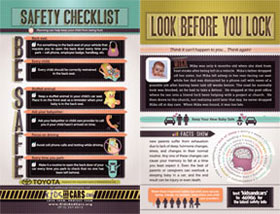|
Twittercue: 7 child heat-stroke deaths in cars in 16 days: #KidsAndCars.org. See http://ow.ly/ldDwU
News Release
KidsAndCars.org
7532 Wyoming St., Kansas City, Mo. 64114
Office: 816-216-7085, www.KidsAndCars.org
Contacts:
Janette Fennell, 484-278-4641, cell 415-336-9279 or [email protected]
Amber Rollins, 816-216-7085 or [email protected]
|
May 2013 nearly doubles average number of child
heatstroke deaths in vehicles
7 children die in hot cars in 4 states in 16-day period
KidsAndCars.org offers life-saving tips as warm weather increases danger
|
|
|
|
June 3, 2013 - Summer hasn't even arrived, and yet already this year seven children have died of heat stroke after being left in vehicles.
KidsAndCars.org reports the following deaths in a 16-day period in May:
- A girl, 5 months, died May 10 in El Paso, Texas, after her mother, a high school teacher, unknowingly left her behind in her SUV.
- A boy, 4, died May 15 in Transylvania County, N.C., after his grandmother forgot to drop him off at daycare.
- A boy, 11 months, died May 16 in Miami, Fla., died after being left behind in his mother's car.
- A girl, 1, died May 17 in Dallas, Texas, after her mother, an elementary school teacher, unknowingly left her behind in her vehicle.
- A boy, 1, died May 24 in Corpus Christi, Texas, after his uncle forgot to drop him off at daycare.
- A boy, 18 months, and girl, 2 months died May 26 in Glen Allen, Va., when they were left in the car while the mother was at work.
All of the children were left by a family member, and all but one child were under age 2.
"The worst thing any parent or caregiver can do is think that this could never happen to them, that they are not capable of inadvertently leaving their child behind," says Janette Fennell, founder and president of KidsAndCars.org, the leading national nonprofit child safety organization working to prevent injuries and deaths of children in and around motor vehicles.
"This can and does happen to the most loving, responsible and attentive parents." Since the group began tracking data, more than 675 children have died in these preventable tragedies.
|
|
|
Safety Tips from KidsAndCars.org
 | | Click here to view card |
Remember the following "Look Before You Lock" BE SAFE tips from KidsAndCars.org:
Back seat - Put something in the back seat so you have to open the back door when leaving the vehicle - cell phone, employee badge, handbag, etc.
Every child should be correctly restrained in the back seat.
Stuffed animal - Move it from the car seat to the front seat to remind you when your baby is in the back seat.
Ask your babysitter or childcare provider to call you within 10 minutes if your child hasn't arrived on time.
Focus on driving - Avoid cell phone calls and texting while driving.
Every time you park your vehicle open the back door to make sure no one has been left behind.
Through the "Look Before You Lock" educational campaign, the first of its kind, KidsAndCars.org has distributed more than 300,000 information cards to birthing hospitals nationwide.
KidsAndCars.org urges everyone to read "Fatal Distraction," Gene Weingarten's Pulitzer Prize-winning article in The Washington Post at http://ow.ly/ldDwU, which explains how these heartbreaking and preventable tragedies can happen to anyone.
KidsAndCars.org fully supports the National Highway Traffic Safety Administration's (NHTSA's) new program, "Where's Baby, Look Before You Lock."
###
|
|
|
About KidsAndCars.org: Founded in 1996, KidsAndCars.org is a national nonprofit child safety organization dedicated to preventing injuries and deaths of children in and around vehicles. KidAndCars.org promotes awareness among parents, caregivers and the general public about the dangers to children, including backover and frontover incidents, and heat stroke from being inadvertently left in a vehicle. The organization works to prevent tragedies through data collection, education and public awareness, policy change, product redesign and survivor advocacy.
|
|
|
|
|